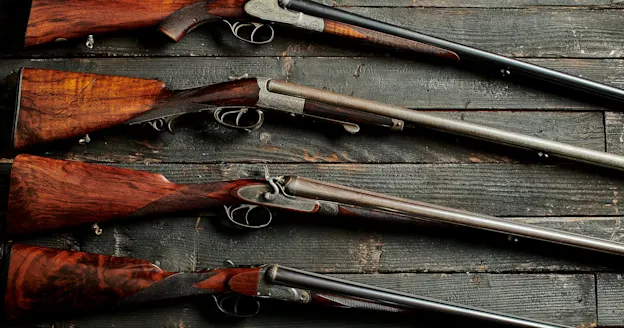WELL PAST MIDNIGHT, Tim Reed and Rodney Smith paddle down a skinny stretch of water in northern New York, to a spot where the high-cut riverbank transitions to flood plain. As Smith makes one last quiet push, gliding the yard-sale canoe toward a tangle of lily pads and skunk cabbage, Reed leans over the bow. The wide-set eyes of a big bullfrog glow in the beam of his headlamp, and just as the canoe reaches the jacklighted frog, Reed strikes.
“Argh!” he yells through a splash of river water. Then he holds up his prize: A meaty bullfrog is mashed between his index and middle fingers, its long legs dangling almost to his elbow. “Gave him the ol’ kung-fu grip!” Reed says. Smith laughs. Reed gives the frog a whack on the gunwale, then drops it into a wire fish basket behind him. The two have been at this for several hours now, and the first of two fish baskets is full—50 or 60 large bullfrogs piled atop each other like a mess of balled socks in a hamper. Smith paddles the canoe to the bank for a quick break. They step out and click off their headlamps.
“It’s pretty with the lights out,” Smith says.
“Just us and the stars,” Reed says.
“And the frogs.”
Green Machines
Reed and Smith have been next-door neighbors for almost 20 years. They spend their summers in small seasonal cabins elevated on concrete pillars on a river in Upstate New York that they made me swear not to name. “We don’t need everyone and their brother knowing where we frog,” Reed tells me.
Of the two, Reed has lived here longer. Born in 1958, he grew up in Theresa, New York. As a boy, he ran traplines with his grandfather, Emery Reed, a local legend, who taught him how to fish and hunt. His grandfather passed away when Reed was 12, and without his mentor and father figure, he started to get into trouble. He was kicked out of school, readmitted, then kicked out again. “You could say I was a restless young man,” he tells me. Reed had kids of his own at 25, but he got divorced soon after and moved to Colorado with visions of hunting mule deer and elk. He worked at a slaughterhouse in Grand Junction to make hunting money, but after less than a year away, he missed his kids and moved back home. A friend let him squat at his cabin on the river. Ten years later, Reed bought him out.
Smith, the older of the two, was born in 1945 in Auburn, New York, and grew up in Montezuma, New York, on the northern edge of the Montezuma National Wildlife Refuge. As a kid, he’d catch frogs by hand in pastures bordering the refuge and use them for bass bait. By high school, he knew the Seneca River better than his own backyard.
“The outdoors and me, we fell in love,” he says. “If there was only one minute to be outside, I took it.” During the war in Vietnam, he was stationed at an Army base in Brandenburg, Germany. He got out in 1975, and he met his wife, Barbara, and they had five kids. Smith started two auto repair shops, which he retired from almost 10 years ago, leaving the business to his boys. “On the intent of having a place to fish, I found this cabin here,” he says. In 2000, Smith bought the place adjacent to Reed’s cabin—and they became neighbors.
“When I first met him,” Smith tells me, “he was living in this here camp year-round.” Limits of ducks hung near the door of Reed’s camp, and the back deck was covered in deer hides waiting to be tanned. “I thought, Boy, here’s a real woodchuck. We hit it off right at the bat.”
“I liked him right away,” Reed says.
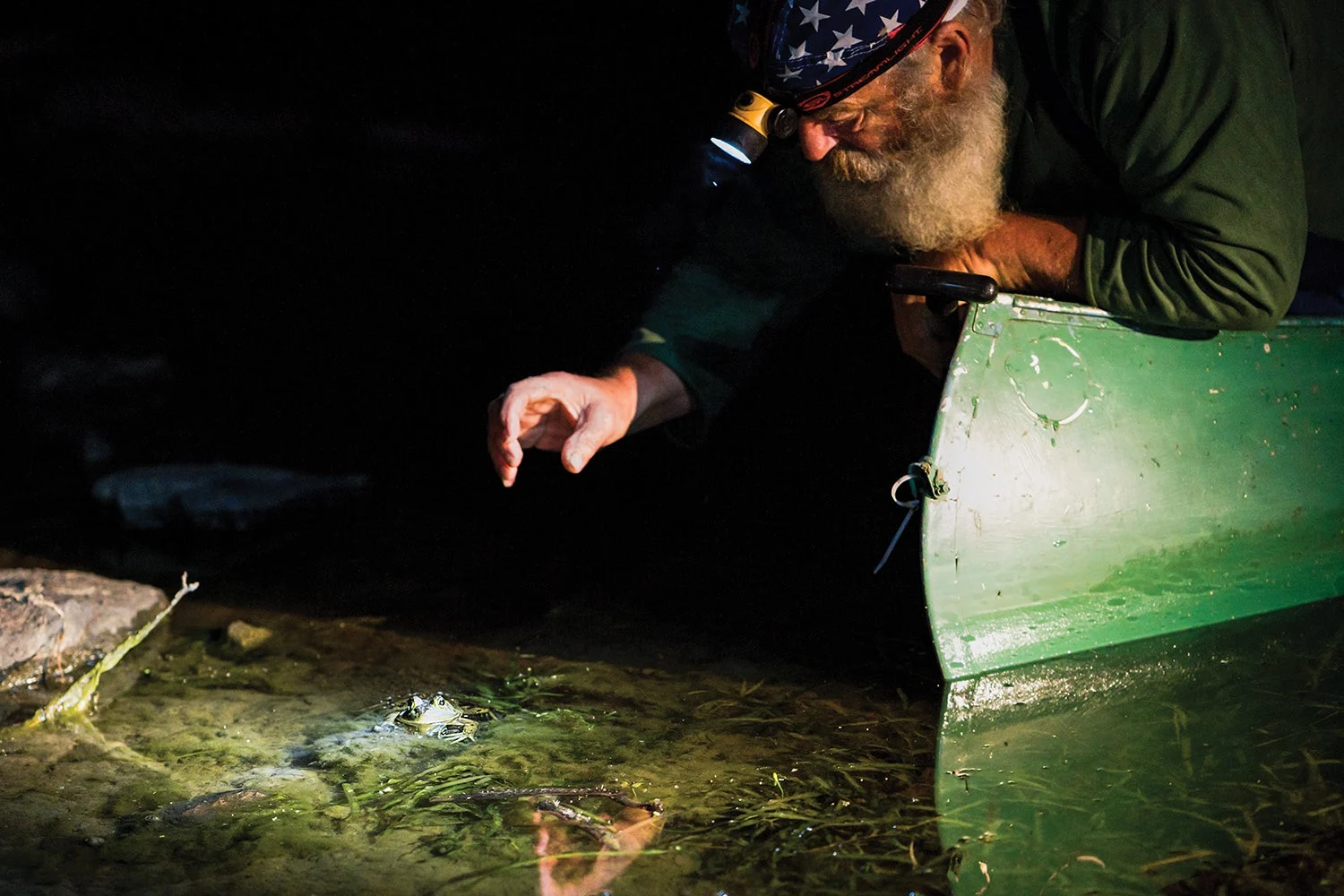
Reed spies a meaty bullfrog. John Loomis
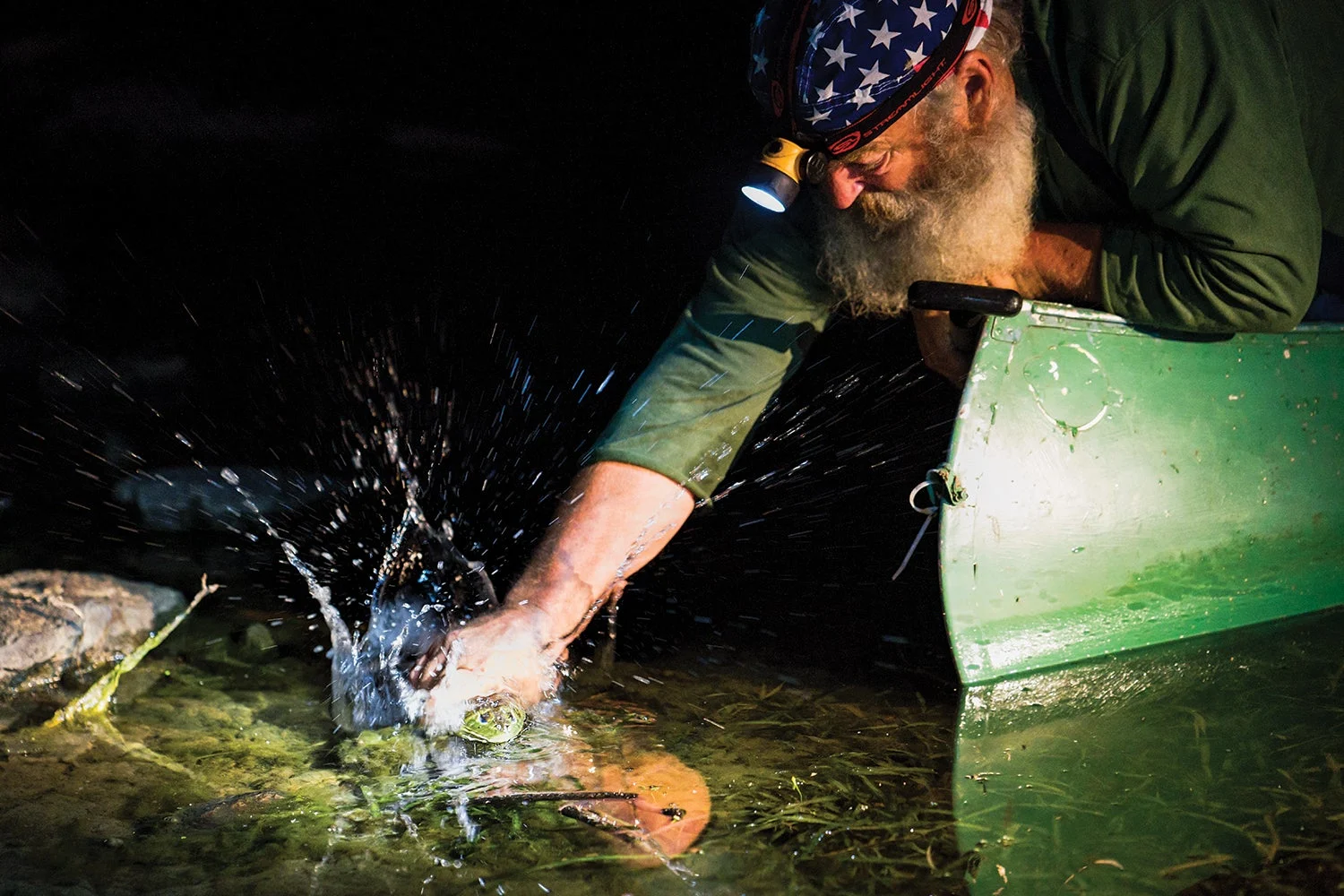
He sneaks in for a grab. John Loomis

Success. John Loomis
In those early years, Reed and Smith fished together in the spring, hunted together in the fall, and chased frogs together in the summer, snagging big males with poles and treble hooks during the day. Then in 2008, New York changed its harvest regs for reptiles and amphibians, and made targeting frogs at night legal. After-hours frog hunts sounded like fun, so Reed bought a little three-tined frog gig at Walmart. It didn’t take them long to smash and mangle that toy spear down to a single tine. “Piece of junk,” Reed recalls. They tossed it and tried taking frogs by hand in Reed’s old Grumman canoe. Smith, who’s pencil-thin, paddled Reed, who’s a self-described “short, fat, and bald guy,” around from the stern. Reed would dangle off the bow, jacklighting frogs in his headlamp. That first night, after the first few grabs, Reed looked back at Smith and said, “This is gonna work!” Later that weekend, because they’d had so much fun hunting frogs at night, they decided to give their canoe a name, painting in white letters on each side, Frogzilla.
For a while, night-frogging in the summer was just one more adventure Smith and Reed did together; they were still each other’s best hunting and fishing buddy. But in 2010, Reed was in a car accident that shattered his spine. He’s had two surgeries but still struggles daily. “I can’t do much of anything very long,” he says. Fishing, duck hunting, and deer hunting were out. All that was left was frogging.
They installed a 1.5-inch closed-cell foam pad in the bow of Frogzilla so Reed could kneel in the canoe instead of sit, which is too painful for any stretch of time. By kneeling, Reed found he could comfortably hunt for hours on end—summer night after summer night. “I used to be a 260-pound monster, could do whatever I wanted,” he says. “I’m a 260-pound slug now. Can’t do shit. But I can go frogging.”
I first met Smith and Reed seven years ago, through a mutual friend of Reed’s son, Arliss. After my first trip to the river-that-can’t-be-named, I was so impressed by their ability to stack up big bullfrogs—“meat frogs,” as Smith and Reed call them—that I nicknamed them the Frog Kings in a video series for F&S. A lot of people around these parts must have seen those videos, because it’s not uncommon for Reed or Smith to be pumping gas only to hear someone yell from a passing truck, “Frog Kings! Yeah, buddy!” Last summer, they invited me back for a couple of nights of frog hunting so I could hear their story—and learn more about what makes these two so good.

For frogs that are out of arm’s reach, Smith and Reed use a gig. John Loomis
Methods to the Madness
“What do you think, Pops?” Reed asks Smith, standing on a muddy bank. “Head back?”
“Yep,” Smith says. “Take the other side home.”
It’s almost 1 a.m., and while the Frog Kings are retreating, they’re only halfway finished. They’ve frogged one side of the river up from camp; now they’ll frog the other side back. “Look at ’em all,” Smith says, spotlighting the opposite shoreline. Half a dozen sets of eyes glow back at us.
“That’s a good one on the end,” Reed says. “Let’s put our hands on ’im.”
Reed and Smith have perfected three techniques for catching huge numbers of bullfrogs. The simplest method is by hand. Smith paddles Reed to within arm’s reach so he can grab the frog and decide whether it’s big enough to kill and eat. “Jake,” Reed will say of smaller frogs and toss them back in the water.
For frogs that are too high on the riverbank for a hand grab, Reed will reach for the Devil’s Tines—an oversize gig that Reed can throw with ridiculous accuracy.
“Bull’s-eye!” Smith yells when Reed connects.
Finally, there’s the 22 Magnum. This isn’t a gun, but rather a short aluminum boat paddle with a piece of rebar in the shaft they use when a frog is just out of arm’s reach. Brought down hard on a bullfrog’s head, it takes the jump out fast. Nothing gets Reed and Smith laughing more than the clap of the 22 Magnum. “It stiffens them right out,” Reed says. “Like you touched them with electricity, they’re done.”
In northern New York, the frog chorus starts up in late April and runs through August, but the best time to go frogging is during the heat of July, when the males cluster together and sing to attract breeding females. Anywhere a swamp or wet lowland meets the river, you can pick out dozens of sets of eyes in the dark with a bright light. You can tell males and females apart by the tympanum—that disk-shaped eardrum on the side of a bullfrog’s head. If it’s larger than the eye, it’s a male; smaller, it’s a female. Eyes are also a good way to field-judge bullfrogs: Meat frogs have wide-set eyes that glow in the beam of a headlamp.
Clap!
The 22 Magnum explodes on the river’s surface just off the opposite shore. “Yup,” Reed hollers. “He was a good one.”
Arliss and I follow the Frog Kings from a second boat. I watch as Smith coasts Frogzilla around a bend in the river. Reed, hanging off the bow port side, grabs a small frog and tosses it back in the water. Moments later, he leans hard left again and grabs a good one. As they go around the turn, Reed rummages in the canoe for the Devil’s Tines. He raises the spear back above his head and sends it off into the night.
“Bull’s-eye!” Smith shouts.
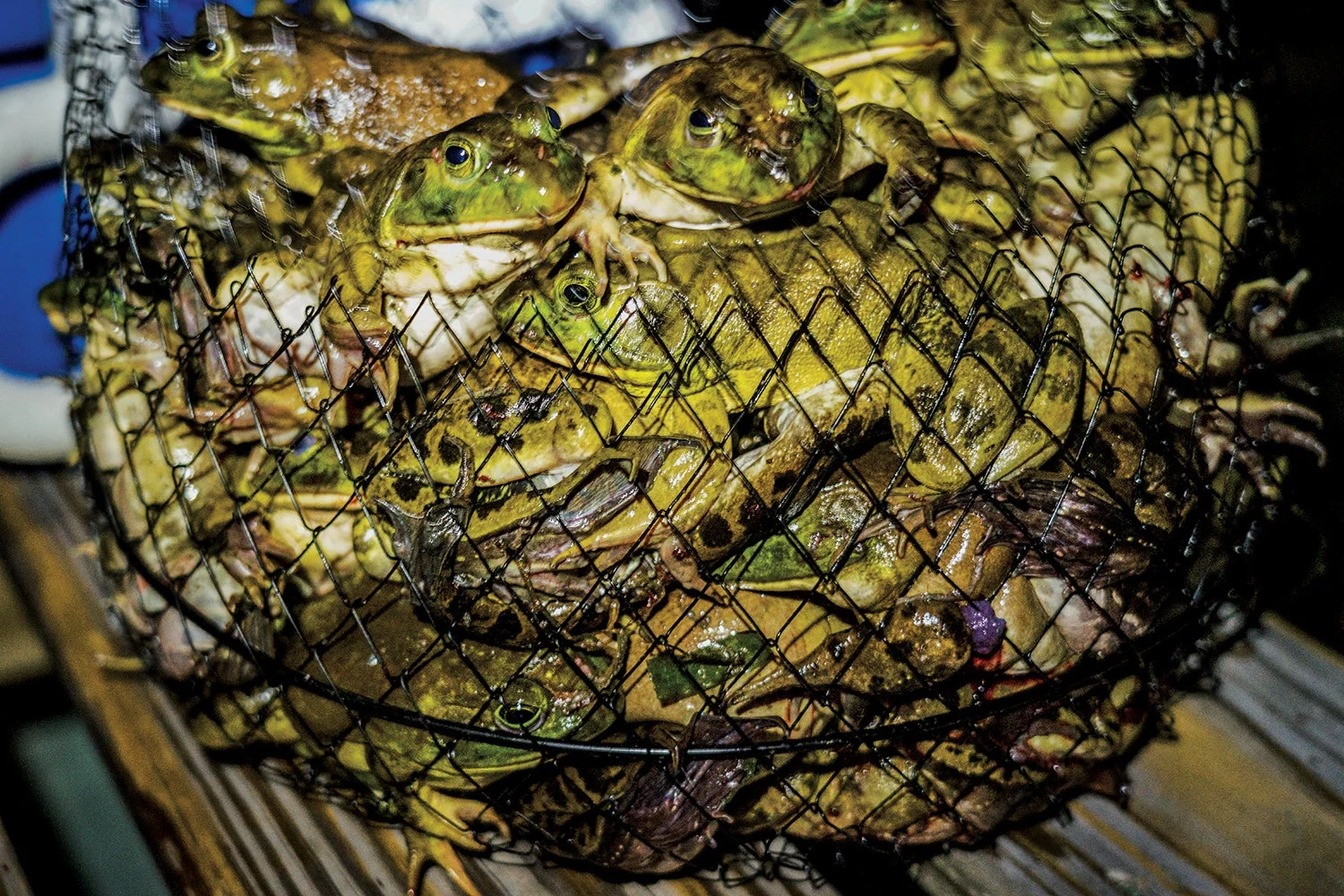
As is the case with any hunt, the real work begins after the kill. John Loomis
Haul of Fame
The next morning, Reed is sitting in his camp living room, shirtless in pajama pants, working on his second smoke and a cup of coffee. It’s still dark outside, but Smith is already dressed and loading fishing gear into his small V-hull. Reed walks out to the deck and hollers, “Morning!”
“There’s work to do,” Smith shouts back.
Reed and Smith have honed a brutally efficient way to process so many amphibian hindquarters, and it’s always done first thing the morning after a hunt. At a table outside Smith’s cabin, Reed pulls a frog from the basket. He cuts it in half at a high spot on the frog’s back with a pair of kitchen shears, then grabs the skin at the base of the spine with a set of pliers and peels it off. He passes the frog to Smith, who cuts off the feet, and both legs at the pelvis. The legs go in a tub; the pelvises in a pile. I ask why they don’t keep the legs attached, like you see in restaurants. Reed slaps a skinned set of legs on the table and points to the groin. “Crotch,” he says. “We don’t eat crotch.”

Smith and Reed spend hours skinning and butchering their frogs. John Loomis
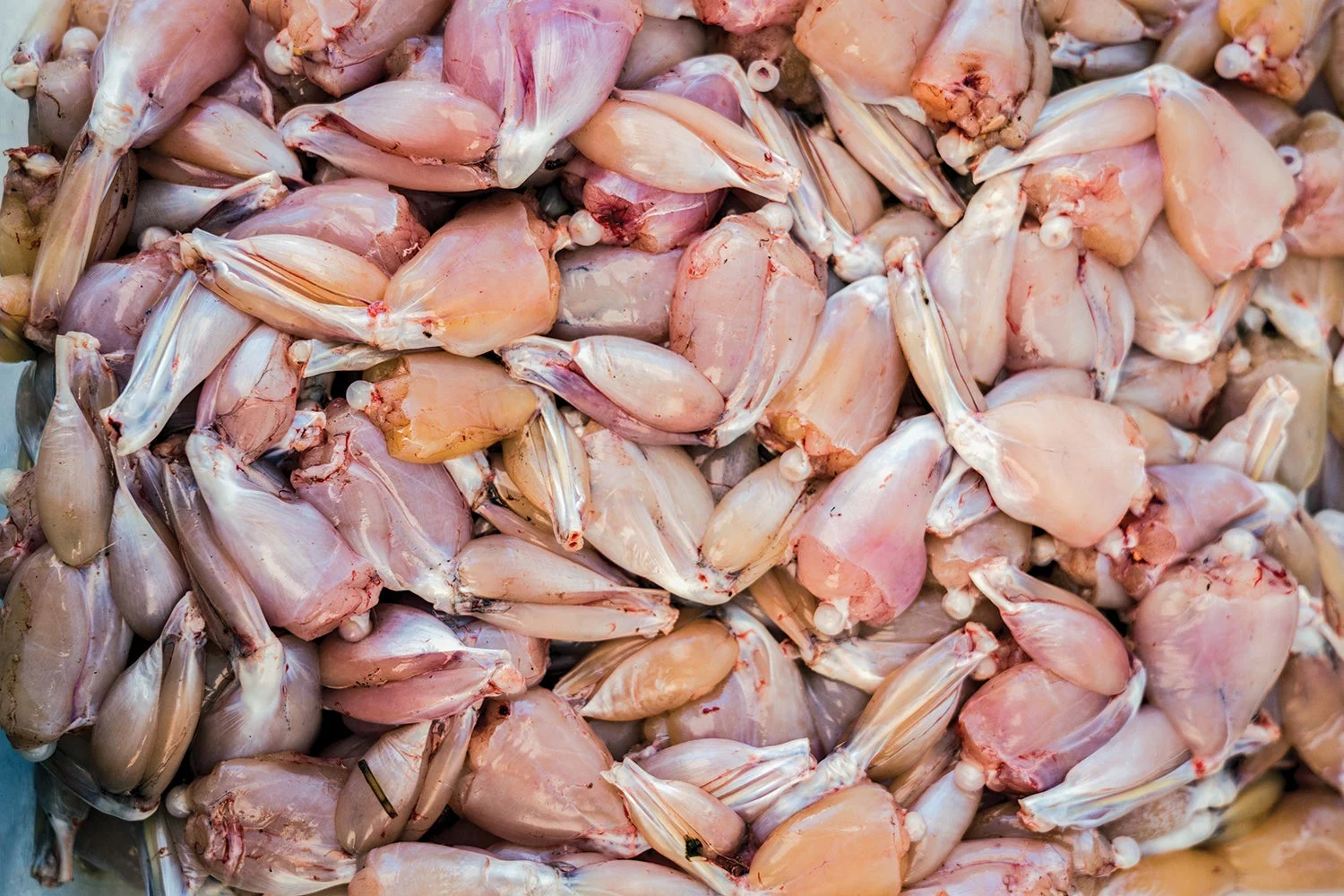
A pile of leg meat. John Loomis

They’ll cook frogs legs for parties—and even enjoy them for breakfast. John Loomis
Smith walks to his place for Ziploc bags while Reed begins counting the pelvises, two at a time, so they can tally their haul.
“Ninety-four… 96… 98,” Reed counts. “Ninety-eight. We got 98.”
“Man,” Smith says. “We suck.”
They aim to get 100 frogs a night.
It takes 10 big males to make a pound of frog legs, which means Smith and Reed are looking at nearly 10 pounds of tender white meat, which they’ll grill or fry and serve at parties. They also like to roll the legs in pancake batter and eat them for breakfast with maple syrup. It’s one of Smith’s old fish-fry recipes. “But frogs,” Reed says, “taste way better than fish.”
Final Float
At 9 p.m., we get ready for our last trip on the river together. Reed tells me that the best nights for frogging are ones that are humid and buggy. “Bugs out, frogs out,” he says. He’s dressed in a stained white T-shirt tucked into blue jeans with navy suspenders and a Harley-Davidson do-rag. His full white beard bounces with every step. (In the winter, he works part-time as a shopping-mall Santa Claus.) He drags Frogzilla toward the bed of his GMC. Smith gets in the front seat, and we head for the river.
They launch the canoe, and the first bullfrogs sound off well down the river—but then the chorus gets louder as we close in. You’d think these guys—as many frogs as they kill—would have frogged out their home waters, but it sure doesn’t sound like it. Once again, I’m trailing behind them in a second boat with Arliss. We nose in close to Reed and Smith along a shoreline pock-marked with muskrat huts and hummocks of swamp grass. Reed makes a grab, but the frog jumps away, then swims to safety.
“Strike!” Smith hollers.
“That’s my first miss in a week!” Reed says.
“We needed that one.”
When a miss happens, which is rare these days, they dissect it play by play. This frog was facing forward, Reed says, and a front-facing frog is a hard frog to grab. They jump as you strike, and if you get them, it’s often by the toes. Reed adds that if the frog is facing forward, it’s easy to break the beam of the headlamp with your hand, spear, or paddle. And if you break the light, the frog will almost always jump. Broadside is best for every implement—a hand grab, a gig through the side, or a smack with the 22 Magnum. Facing away is almost always good too, because the frog won’t see you coming—just make sure you aim the gig well up away from the legs.
Arliss notices a big bullfrog about 6 feet up the river and keeps it fixed in his headlamp as he creeps our canoe upriver. I get into position and throw my gig. The frog jumps, but I got him. Proud as hell, I dangle the meat frog out for Reed and Smith to see—but the Frog Kings aren’t so impressed.
“Meat damage,” Reed says, pointing out that I clipped one of the legs.
“Too far back,” Smith adds.
The Frog Kings paddle on ahead of us. “Argh!” Reed yells. In my headlamp, I can see him bring up a huge bullfrog in his kung-fu grip.
“Look at that son of a gun!” Smith says.
“That’s an eater, boys!” Reed hollers.
It’s past 4 a.m. when we get back to camp and unload the heavy baskets full of frogs. When I wake up a few hours later, the cabin is empty, but Smith and Reed have left a tray of hot pancake frogs on the kitchen counter. I find them outside at the cleaning table.
Reed does the counting: “One-fifty-four… 156… 158! Man, that was a good night!”
Smith takes a drag on his smoke, then grins. “Maybe we don’t suck after all.”





